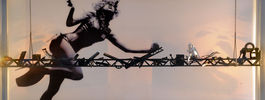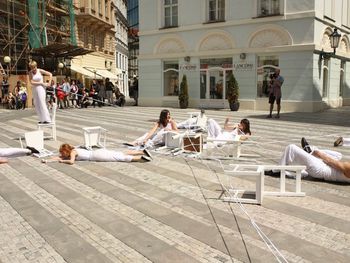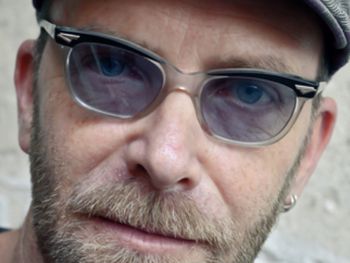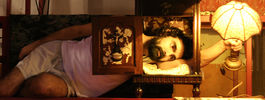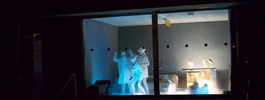Scenarist of the exhibition: Tove Ahlbäck, Maija Rotko
The first theatre to play in the Finnish language was founded in the seventies of the last century and served as one of the signals of the new awakening of national consciousness. Until the beginning of the twentieth century this theatre constantly traveled throught the country. It was thus a truly national theatre, both in name and by its impact.
Finland never has its own court theatre and thus its whole theatre tradition was born from the national and working class movements and from various youth organisations. Out of these amature societies, which included actors, stage designers and directors, the first professional theatres arose. During the period of their greatest flourishing, there were more then 2 000 amature theatrical societies of workers and of youth.
During the twenties of the present century German and Swedish theatrical terms came to be used, in spite of the fact that the nature of the productions was purely Finnish.
In the forties stage productions were strongly influenced by world renowned Finnish industrial designs, which led to the introduction of new forms and materials also into stage designing. The systematic education of stage designers began in the fifties, at the Finnish Drama School; later the curriculum at the School of Applied Arts in Helsinki was made more specialized in this respect by Pekka Heiskanen. His most important aim was to bring school education closer to the practical activities of professional theatres.
During the sixties Finnish stage design underwent great development. The majority of the stage designers of this period are still active. There are approximately 50 stage designers active in Finland today. Roughly half of them work in old buildings of former youth clubs, etc, while the other half work in either old or new, modern theatre buildings. With the construction of the Small Scene of the National Theatre in Helsinki a whole series of constructions of new theatre buildings was begun; the most recent addition
to this series is the Municipal Theatre in Rovaniemi.
The following brief characteristics represent the opinions of some of the best known Finnish stage designers.
Leo Lehto's work is characterized by his fantasy and imagination. He was at the National Theatre in Helsinki; in 1966 he came to the Municipal Theatre of Helsinki, where he designed excellent stage sets for comedies, productions for children and for operettas. His stage sets for Shakespeare's comedies and for fairy tales were especially successful.
Rolf Stegars, a student of Matti Warén, is dedicated to experiments in stage design. His design for the stage sets to Strindberg's Dream Play was considered to be avant-guarde, as well as his stage designs for Moliere's, Shakespeare's and Sheridan's plays, which were very pure from the point of view of space and the materials used.
Pekka Heiskanen studied at the School of Applied Arts. He has introduced new scenic materials and places special stress on the formation of space and three dimensional objects on the stage. A typical aspect of his work are sets with only several details, which are, however, elaborated with precision; they have also appeared in the work of numerous young artists. Of his work, the stage designs for Buchner's Leonce und Lena and Danton's Death deserve special mention.
Seppo Nurmimaa works mostly for the National Opera, but often also collaborates with a number of other Finnish, as well as Scandinavian theatres and with television. His stage sets are characterized by a richness of forms and a very finely elaborated stage design, to which he almost always adds costume studies. As guest stage designer he designed the sets for Musseťs Lorenzaccio at the National Theatre in Helsinki.
The work of Eero Kankkunen is characterized by the rich variety in which he uses wood, both in the natural and processed form. His stage sets made of wood for Pakkal's play Timber Floating were a major contribution to the -success of the play.
Veikko Mäkinen works with the Theatre in Tampere,where a number of musicals and operettas are on the program. His first success were the stage designs for West Side Story. He has also collaborated with a number of other theatres throughout the country.
Yrjö Tapper is one of the brothers, who have made an important contribution to Finnish culture and art. He most recent work of importance are the stage designs for o'Casey's Purple Dust.
Kaj Puumalainen is at the Municipal Theatre in Turku, which is characterized by its great activity and iniciative. He endeavours above all to capture the fundamental idea and significance of a play, so that on its basis he can choose the most relevant mode of expression and economic means of scenic design. The results of this creative method are especially evident in the stage sets for Chekhov's The Three Sisters and Kivi's The Seven Brothers.
Juha Lukala, in spite of his youth, is known as a highly talented professional and is especially sought by those theatres, which plan difficult and complex productions. He works, among others, for the Municipal Theatre in Turku, where he designed simple and very beautiful stage sets to such plays as Shakespeare's King Lear and B. Brechťs Galileo.
In the Finnish theatres there are not more than ten costume designers active. The main reason for this low number is that this branch is quite new and many of the stage designers act as costume designers, too. In spite of the smallness of the group, the designs are of a high international order.
The exhibitors and their work will show clearly the meaning an intention of what we may call typical Finnish stage design.
- Timo MARTINKAUPPI
Additional information: Born in 1941; stage designer, he also writes for radio and television. During 1970-1972 he was a lecturer at the School of Applied Arts and the Finish School of Drama. He collaborates with various municipal and travelling theatres as a designer, on a free lance basis. He is a member of the Union of Finish Stage Designers and a member of its executive committee.
Obrázky z katalogu
- Pekka Heiskanen
Additional information: Born in 1929 in Lappeenranta. Studied at the School of Applied Arts in Helsinki,also in Spain, France, Greece and German Federal Republic. From 1951 he has been stage designer at The Finnish National Theatre in Helsinki. From 1955 he has taught stage design at the School of Applied Arts in Helsinki, is president of the Association of Finnish Stage Designers. He works as guest stage designer at theatres in Vienna, Copenhagen, Turku, Tampere, Joensuu. His most significant works include Iphigenie in Aulide, The Cid, Agamemnon, The Death of Danton, The Merry Wives of Windsor, Tango, Leonce and Lena.
Obrázky z katalogu
Exhibiting works
-
: (Johny Johnson),
Suomen Kansallisteatteri
1975, Director: Vili Auvinen ,
-
Jaques Offenbach: (La Belle Heléne),
Turun Kaupunginteatteri
1972, Director: Kalle Holmberg,
-
Moliere: (Tartuffe),
Suomen Kansallisteatteri
1973, Director: Esko Elstelä,
- Eero Kankkunen
Additional information: Born in 1920 in Viipuri. He studied at the School of Applied Arts in Helsinki, the Soviet Union and Poland. From 1959 he worked as a stage designer in the Tampereen Tyovaenteatteri. In 1967 he worked as a guest designer in the Trondheim theatre, in 1968 in the Kuopion Yhteisteatteri, in 1972 in the Suomen Kansallisteatteri. His most significant works are Hamlet, Macbeth, The Cherry Orchard, My Fair Lady, The Resistible Ascension of Arthur Ui.
Obrázky z katalogu
Exhibiting works
-
: (Don Quixote),
Tampereen Työväenteatteri
1975
- Veikko Mäkinen
Additional information: Born in 1928 in Helsinki. Studied at The School of Fine Arts. From 1953-1959 he worked as stage designer for the Vaasan Suomalainem Teatteri Theatre, from 1959 he has been stage designer at the Tampereen Teatteri. Worked as guest stage designer at the Tampereen Ooppera, Tutun Kaupunginteatteri and at the Helsingin Kaupunginteatteri. His most significant works include Oliver Twist, West Side Story, The Beggar's Opera, Zorba the Greek, Othello.
Obrázky z katalogu
- Seppo Nurmimaa
Additional information: Born in 1931 in Kerava. Since 1957 he has been working as a stage designer at the Finnish National Opera. He participated in the PQ in 1967 and in 1975.
Obrázky z katalogu
Exhibiting works
-
: (The Barber of Sevilla),
Suomen Kansallisooppera
1973
-
: (Sorochinsk Fair),
Suomen Kansallisooppera
1974
-
: (A Midsummer Night's Dream),
Suomen Kansallisooppera
1972, Director: Sakari Puurunen,
-
Sergei Prokofiev: (Fantasma),
Suomen Kansallisooppera
1971, Director: Lars Runsten,
-
Alfred de Musset: (Lorenzaccio),
Suomen Kansallisteatteri
1974, Director: Esko Elstelä,
-
: (Otello),
Suomen Kansallisooppera
1974, Director: Lars Runsten,
- Paul Suominen (Paul Rafael Suominen)
Additional information: Born in 1930 in Helsinkl. In 1948 to 1953 he was trained in stage
design in the Svensk Teatern in Helsinki. In the years 1955-1973
he worked as a stage designer and costume designer at the Suomen
Kansallisooppera and occasionally also at the Lilla Teatern
under the guídance of Wivici Bandler. It was here that he designed
stage sets for Daria Fo, who directed his own plays. In
the period 1976-1977 he worked in the Stockholm Municipal Theatre.
Since 1973 he is head of the department of stage design at the
Academy of Applied Arts in Helsinki. In 1975 he received the
Bronz Medal at the Triannial of stage and costume design at Novi
Sad in Yugoslavia for his concept and realization of the stage
sets for Goethe' s Faust. He participated in the Prague Quadrennial
in 1975.
- Juha Lukala
Additional information: Born in 1940 in Turku. Studied at the School of Fine Arts in Turku. From 1962-1965 he worked as assistant of stage design in the Turun Kaupunginteatteri. From 1970-1972 he taught stage design at the Drama Studio at the University in Tampere. Since 1965 he has been stage designer at the Turun Kaupunginteatteri. He worked as guest stage designer for the Stockholms Stadsteatern in 1973 and in Helsingin Kaupunginteatteri in 1974. He was awarded a Diploma of Honour at the Prague Quadrennial in 1971 and at the Novi Sad Triennial in 1972. His most significant works are The Life of Galileo, King Lear, Strindberg's Father.
Obrázky z katalogu
Exhibiting works
-
: (King Lear),
Turun Kaupunginteatteri
1972
-
: (Galileo),
Turun Kaupunginteatteri
1974
-
: (The Fiery Red Flower),
Helsingin Kaupunginteatteri
1974
- Tove AHLBÄCK
Additional information: Born in 1945 in Helsinki. From 1965 - 1971 studied at The School of Applied Arts in Helsinki. In the school year 1970-1971 she specialized in scenography at the same school. From 1972-1974 she studied on a Asla-Fulbright scholarship in the USA. While studying she worked as stage and costume designer at the Suomen Kansallisteatteri. From 1975 she has worked at the Tampereen Työväenteatteri. In the years 1972 and 1974 she worked as guest designer at the Turun Kaupunginteatteri, in 1974 at the Svenska Teatern in Helsinki.
Obrázky z katalogu
Exhibiting works
-
: (The Land is Stained),
Kustaa Turun Kaupunginteatteri
1974
-
Maxim Gorkij: (The Time of Zykovs),
Tampereen Työväenteatteri
1975, Director: Lasse Pöysti,
- Egil FALCK
Additional information: Born in 1938. He studied at the Swedish School of Decorative Arts, between 1962 and 1965 he worked and studied at the Svenska Teatern in Helsinki, where he worked as a stage designer until 1970 and since 1970 he is the first stage designer. On the basis of guest collaboration he has designed numerous sets for drama productions in smaller theatres; he also collaborates with television.
Obrázky z katalogu
Exhibiting works
-
: (Panic in the Village of Rölleby),
Svenska Teatern
1975
-
: (Intermezzo in the Kämp Restaurant),
Svenska Teatern
1975
- Ralf Äke Forsström (Ralf Forsström)
Additional information: Born in 1943 in Helsinki. He studied interior architecture and currently operates as freelance stage and costume designer and director over the whole of Scandinavia. Teaches at the University of Art and Design in Helsinki. Participated in the PQ in 1983 (honour diploma). Recipient of Pro Finlandia Award (1996).
Obrázky z katalogu
Exhibiting works
-
: (Hard Times),
Svenska Teatern
1974
- Mauno HARTMAN
Additional information: Born in 1930 in Turku; a sculptor. Since 1950 he studied at the Arts Society School in Turku and between 1950 and 54 he worked and studied at the Warsaw Ateheum Theatre, between 1957 and 1958 at the Academy of Arts in Perugia, Italy and in 1959 at the Academy of Arts in Venice, Italy. In the years 1961, 1964 and 1972 he held one man exhibitions in Helsinki, in 1956, 1957, 1962, 1964 and 1969 in Turku, in 1963 in Hämmenlinna, in 1970 in Lahti, in 1966-67 he participated in exhibitions in Sweden and Denmark, in 1968 he participated in the XXIVth Biennial in Venice, in 1969 in exhibitions
in Denmark and in 1972 on Iceland. Between 1955 and 1972 he obtained numerous scholarships, in 1968 he received an Art Union Prize.
Obrázky z katalogu
- Pekka OJAMAA
Additional information: Born in 1947. Between 1968 and 1972 he studied at the School of Applied Arts in Helsinki.He has designed numerous stage sets for plays produced by popular travelling theatres, as well as for productions in municipal theatres. At present he is active as a free lance artists. He' is a part- time lecturer at the School of Applied Arts and at the Finish School of Drama. He is also the secretary of the Finish Center of OISTT.
Obrázky z katalogu
Exhibiting works
-
: (Children of Misfortune),
Jyväskylän Kaupungin Teatteri
1974
- Paavo PIRTTIMAA
Additional information: Born in Jyväskylä. Studied at the School of Fine Arts in Helsinki. From 1965 - 1975 he worked as stage designer at the Tampereen Työväenteatteri, from 1975 at the Lahden Kaupunginteatteri.
Obrázky z katalogu
Exhibiting works
-
Heinrich von Kleist: (Michael Kohlhaas),
Tampereen Työväenteatteri
1974, Director: Lisbeth Landefort,
- Paavo PISKONEN
Additional information: Born in 1944. He atudied at the School of Applied Arts in Helsinki. Later he became a member of the professional folk theatre Penniteatteri, which travels all over Finland and also plays for the Finnish minority living in Sweden, especially in places, where no theatre, in any form, has yet played. Its program also includes plays for children and youth.
Obrázky z katalogu
Exhibiting works
-
: (The Magic Horse),
Penniteatteri
1975
- Kaj PUUMALAINEN
Additional information: Born in 1936 in Fiskars. Studied at the School of Applied Arts from 1953-1956. He works as assistant of stage design at the Svenska Teatern in Helsinki, from 1957 he has worked as stage designer at the Turun Kaupunginteatteri and at the Samppalinnan Kesäteatteri. In 1974 he worked as guest designer at the Municipal Theatre in Bremen.
Obrázky z katalogu
Exhibiting works
-
: (The Cherry Orchard),
Turun Kaupungunteatteri
1974
-
: (The Good Woman of Setzuan),
Turun Kaupungunteatteri
1975
- Anneli QVEFLANDER
Additional information: Free lance artist. Works as stage and costume designer for various theatres; Suomen Kansallisooppera, Helsingin Kaupunginteatteri, Suomen Kansallisteatteri, Savonlinnan Ooppera Juhlat. Her most important works include Boris Godunov, Pagliacci, The Turning of the Screw.
Obrázky z katalogu
Exhibiting works
-
: (The Turning of the Screw),
Suomen Kansallisooppera
1968, Director: Jack Witikka,
-
: (Love of Three Oranges),
Suomen Kansallisooppera
1969
-
Modest Petrovič Musorgskij: (Boris Godunov),
Savonlinnan Ooppera
1974, Director: Jack Witikka,
-
Ruggero Leoncavallo: (I Pagliacci),
Suomen Kansallisoopera
1969, Director: Jack Witikka,
- Sari SALMELA
Additional information: Born in 1953. For the last three years she has been working for the Municipal Theatre in Kajaani as a costume designer, who also is in charge of props, lighting and sound effects, make-up, hairdressing, is a dressmaker, costume mistress, stage technician and cook in the theatre's snack bar.
Obrázky z katalogu
- Ulla SELINHEIMO
Additional information: Born in 1944. For the last nine years she has been working for the Municipal Théatre in Kajaani as a stage designer, who also is in charge of props, lighting and sound effects, is a hairdresser, make-up artists and designs posters and programmes. The long enumeration of professions both artists undertake is a result of the exceptional situation in which they work. Kajaani is a small town in the north of Finland, surrounded by forests and small villages. The Municipal Theatre, founded in 1906, used to have only three employees. Its only competition is one movie house and one television program. In the vicinity of 200 kilometers there is no other theatre.
Obrázky z katalogu
Exhibiting works
-
: (The Voice of the North),
Kajaanin Kaupungin Teatteri
1975
- Lars-Henrik SCHÖNBERG
Additional information: Born in 1944. He studied at the School of Applied Arts in Helsinki, then worked and studied at the Svenska Teatern in Helsinki, where he was later also employed. He also collaborates with television /Mainos TV/. In 1970 he came to the Tilateatteri. Besides stage designing, he is also active as a graphic artist.
Obrázky z katalogu
- Yrjö TAPPER
Additional information: Born in 1932 in Saarijärvi. Studied at the School of Applied Arts in Helsinki. From 1962-1967 he worked as stage designer at the Tampereen Teatteri, from 1967-1970 at the Suomen Kansallisteatteri, from 1970-1973 at the Porinteatteri and from 1973 is again working at the Tamereen Teatteri. His most significant works are The Balcony, Ivanov, Marat-Sade, Schweik.
Obrázky z katalogu
- Liisi Tandefelt
Additional information: Born in 1936, a costume designer and actress. She studied at the
Academy of Applied Arts, at the Finnish Theatre School and at the
Studio of Dramatic Art at Tampere. Since 1961 she is active as
an actress and costume designer. She has collaborated with foremost
Finnish theatres and with the Finnish Vleísradio. During
1961-63 she was at the Televlsion Theatre, then at the Tampereen
Tyovaenteatteri and at the Municipal Theatre of Helsinki. At
present she is working as a costume designer for the Municipal
Theatre in Turku. She participated in the Prague Quadrennial
in 1975.
- Maija Pekkanen
* 1941
Specialization: costume designer
Additional information: Between 1961 and 1966 she studied at the School of Textiles and Clothing in Helsinki. Her further studies were made possible by the Aino-koti foundation in 1969, a Czechoslovak state scholarship in 1970 and a scholarship from the Finish Cultural Fond in 1971-72. During 1970 to 1972 she studied at the Academy of Creative Arts in Bratislava, Czechoslovakia. She gained her first experiences with work in a theatre at the Municipal Theatre in Kuopiu between 1967 and 1970. Since 1972 she is at the Municipal Theatre in Helsinki. In 1975 she obtained a State grant. She participated in the Prague Quadrennial in 1971, where she exhibited her work within the framework of the exposition of the Bratislava Academy of Creative Arts; in 1975 she participated in the Triennial of Stage and Costume Design in Novi Sad in Yugoslavia.
Exhibiting works
-
: (The Last Temptations),
Suomen Kansalisooppera
1975


